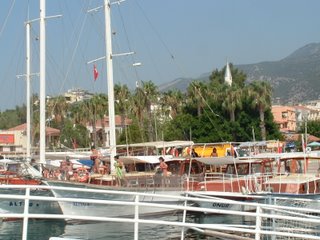 Our base was the small town of Kaş compressed on a narrow band of land between the Taurus mountains and the rocky Aegean coast. Jutting out at about fortyfive degrees to the coast is the Çukurbağ peninsula cradling Kaş in its obtuse angle and forming a rather quizzical brow (Kaş is the Turkish for eyebrow) for the Greek island of Meis (Kastellorizo) which lies less than two kilometres away. Kaş is also the former site of the ancient Lycian port of Antiphellos. It is small but owing to its excellent harbour is cosmopolitan. It is, nevertheless, very Turkish unlike its 'English' neighbours of Kalkan and Fethyie. Other than on Friday, market day, Kaş by day is quiet
Our base was the small town of Kaş compressed on a narrow band of land between the Taurus mountains and the rocky Aegean coast. Jutting out at about fortyfive degrees to the coast is the Çukurbağ peninsula cradling Kaş in its obtuse angle and forming a rather quizzical brow (Kaş is the Turkish for eyebrow) for the Greek island of Meis (Kastellorizo) which lies less than two kilometres away. Kaş is also the former site of the ancient Lycian port of Antiphellos. It is small but owing to its excellent harbour is cosmopolitan. It is, nevertheless, very Turkish unlike its 'English' neighbours of Kalkan and Fethyie. Other than on Friday, market day, Kaş by day is quiet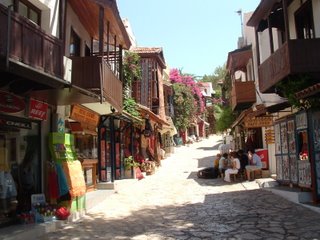 but by evening the harbour is ablaze with lights, cafés and restaurants that suddenly appear in what before seemed to be empty side streets. Shops and bazaars take on a new character but the searing heat and the muezzin's recorded call to prayer from the harbourside minaret remain constant.
but by evening the harbour is ablaze with lights, cafés and restaurants that suddenly appear in what before seemed to be empty side streets. Shops and bazaars take on a new character but the searing heat and the muezzin's recorded call to prayer from the harbourside minaret remain constant.The first week's hotel was the Aqua Park at the very end of the Çukurbağ peninsula set into the steep hillside, leading down to the sea, where there were sun terraces and steps leading into the water. Owing to the location, there were a lot of steps and it is not recommended therefore for anyone who has difficulty in walking. Our room was quite small but had a small balcony overlooking the sea and the island of Meis. The
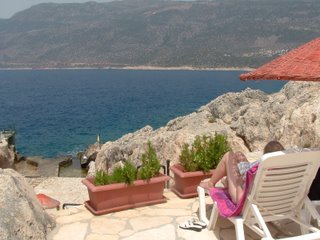 position, however, was idyllic and if we wanted we could always find a quiet terrace with lounge beds where, virtually alone, could sit and read or watch the boats sail by. The typical Turkish two- or three-masted ships were particularly attractive and we always thought of them as 'pirate ships'. 'Gulet' seemed to be the popular name for them but we were told that a real gulet had a round stern rather than a straight one. Real gulets in the area did not seem to be common.
position, however, was idyllic and if we wanted we could always find a quiet terrace with lounge beds where, virtually alone, could sit and read or watch the boats sail by. The typical Turkish two- or three-masted ships were particularly attractive and we always thought of them as 'pirate ships'. 'Gulet' seemed to be the popular name for them but we were told that a real gulet had a round stern rather than a straight one. Real gulets in the area did not seem to be common.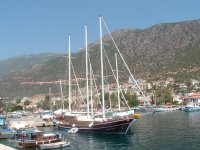
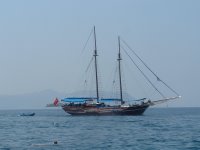
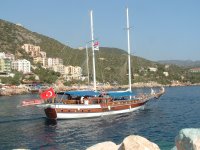
Food in the Aqua Park was of 'buffet' style and was of extremely good quality. Sunday night was 'Turkish night' and the chefs produced specials on barbecues and griddles. Some Turkish folk dancing followed by the inevitable belly dancer. We both managed to avoid been taken on stage for the humiliation of trying to emulate her.
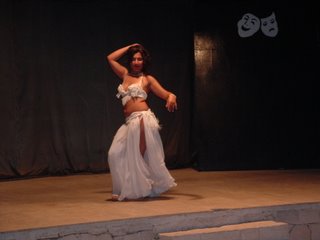
For the second week we moved to the Nur Beach Hotel. This was a family-run hotel just five minutes walk from the centre of Kaş. Despite its magnificent position the Aqua Park was rather isolated and didn't really give us the taste of being in Turkey. This hotel stood twenty-five metres above sea level and though our room and balcony were larger than the ones in Aqua Park the balcony had only a side view of the sea. The 'beach' area, actually a series of wooden terraces built into the rocks with access to the sea, made up for it. Breakfast was served here on the top terrace and below became a space for sunloungers and shades, with snacks and drinks served from a bar.
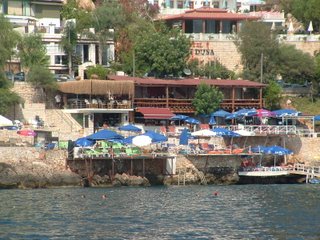
By night the terraces became an attractive a la carte restaurant with candle-lit tables and spotlights reflecting on the water, where Turkish specialities and grills were prepared in the open-air kitchen. Unfortuantely the price that had to be paid was the large number of steps that had to be negotiated but by the time we had arrived we had been well trained by those in Aqua Park.
Our first trip, a two day affair, began with a stop at the ancient town of Hierapolis built on a plateau 200 metres above the town of Pammukale in the Lycos valley. It is an extensive site with a very well-preserved Roman theatre built at the time of the emperor Hadrian which seated up to 15,000. There is also a vast acropolis displaying different grave types.
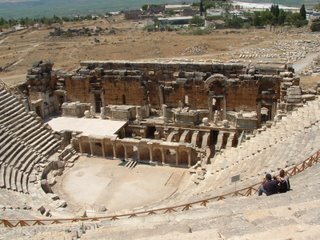
Perhaps, even more interesting than the archaeology was the adjacent land that looked like vast snow fields glistening in the sun complete with frozen waterfalls and skating rinks.
We stopped overnight in Kuşadasi, a lively harbour town, and the following day visited Ephesus. The whole site is vast and we only took in the main sights of the ancient city in a three hour walk from the odeon (small theatre) to the large theatre. It was very busy but somehow the hordes did not intrude on our appreciation. Indeed, the throngs walking down Curetes street, past the Temple of Hadrian down towards the Library of Celsus, somehow transported us to the first century AD.
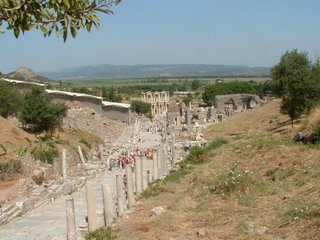
That is what it must have been like. Perhaps one of the little figures in the photograph that was taken from the Memmius Monument could have been St Paul himself!
What was left of the temples and buildings was magnificent, like the Temple of Hadrian and the Library of Celsus, but we were also intrigued by the tunnel that led from the library to the house of Madame Skolastica (the brothel!). We enjoyed minutiae such as the footprint that purported to show a newcomer to the city where the brothel was, the small hole in the middle of Curetes Street surrounded by four others where a torch had been erected as a signal to incoming ships about the state of the city,  and, again, a circle with eight symmetrical radii carved into one of the marble blocks of the street to signify, according to our guide, that the owners of the adjacent shop or house had been converted to Christianity. The guide's rationale for the latter symbol was a bit suspect and we preferred the interpretation of it as a game played by children with stones that was given to us on seeing a similar symbol in Xanthos.
and, again, a circle with eight symmetrical radii carved into one of the marble blocks of the street to signify, according to our guide, that the owners of the adjacent shop or house had been converted to Christianity. The guide's rationale for the latter symbol was a bit suspect and we preferred the interpretation of it as a game played by children with stones that was given to us on seeing a similar symbol in Xanthos.
The monumental masterpiece of Ephesus is the Great Theatre which held 25,000 people. Unlike the theatre of Hierapolis most of the scaenae frons is missing though we did enter the theatre through one of the stage tunnels that have survived. 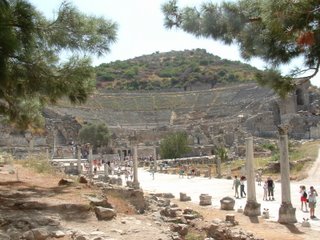 We couldn't help putting ourselves in the shoes of gladiators that would have walked through that cramped space, perhaps to meet their deaths at the hands of colleagues or some wild animal. At least their cries would have been heard at the very back row owing to the superb accoustics of the design. Ironically, some of the back tiers of the theatre have been severely damaged by the attempts of modern pop concert producers to make the voices of some of our most eminent pop stars carry to the back seats!
We couldn't help putting ourselves in the shoes of gladiators that would have walked through that cramped space, perhaps to meet their deaths at the hands of colleagues or some wild animal. At least their cries would have been heard at the very back row owing to the superb accoustics of the design. Ironically, some of the back tiers of the theatre have been severely damaged by the attempts of modern pop concert producers to make the voices of some of our most eminent pop stars carry to the back seats!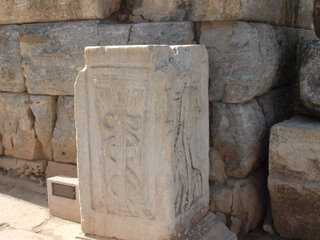 We stood on the stage and, as if from nowhere, a snke-eating eagle hovered above us and though it had a six-foot wing span its white underplumage made it almost invisible against the bright clear sky. The eagle, of course, was a symbol of Rome and, coincidentally, just up the Marble street from the theatre was a stone carved with its prey - a snake entwined around a rod, the symbol of Aesculapius the god of medicine.
We stood on the stage and, as if from nowhere, a snke-eating eagle hovered above us and though it had a six-foot wing span its white underplumage made it almost invisible against the bright clear sky. The eagle, of course, was a symbol of Rome and, coincidentally, just up the Marble street from the theatre was a stone carved with its prey - a snake entwined around a rod, the symbol of Aesculapius the god of medicine.
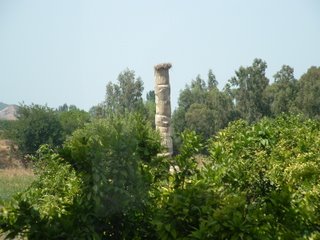 All that is left of one of 'the seven wonders of the ancient world', the Temple of Artemis in Ephesus, is one reconstructed column crowned with a stork's nest. The temple was finally destroyed by the Goths in 263 AD and, the then Christian, people of Ephesus had no time for the reconstruction of pagan temples and used the site as a quarry. Christianity has a lot to answer for and so do the British; some choice finds from the temple discovered in the 19C are safely stored in the British Museum. The Ephesus museum in the nearby town of Selçuk is small but worth the visit if only to see the colossal statue of Artemis which the English archaeologists somehow missed.
All that is left of one of 'the seven wonders of the ancient world', the Temple of Artemis in Ephesus, is one reconstructed column crowned with a stork's nest. The temple was finally destroyed by the Goths in 263 AD and, the then Christian, people of Ephesus had no time for the reconstruction of pagan temples and used the site as a quarry. Christianity has a lot to answer for and so do the British; some choice finds from the temple discovered in the 19C are safely stored in the British Museum. The Ephesus museum in the nearby town of Selçuk is small but worth the visit if only to see the colossal statue of Artemis which the English archaeologists somehow missed.
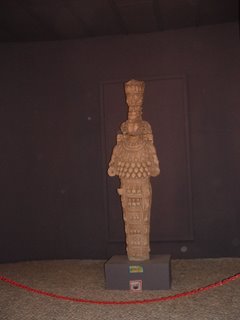
We left Ephesus with the thought that perhaps, unfortunately, our holiday would not be complete without a visit to the British Museum!
A trip to the island of Meis requires patience with bureaucracy. A good half hour before sailing we had to surrender our passports and wait for them to be scrutinised, photographed, or whatever else Turkish customs officials do with them. The journey to Meis took about half an hour and on arrival we had to wait on board while the passports, retained by the boat's captain, were surrendered to the Greek customs, and after a short wait we were invited to land, shoeless, stand on a mat, which could or could not have been connected to some electronic equipment, and be searched if deemed necessary. On returning to Kaş we were instructed to wait for half an hour before collecting the passports. The latter was no hardship because Noel Baba's café/bar was just across the road and a half litre of Efes pilsner beer at 3.5 YTL goes down a treat.
Meis is quite picturesque with its harbour café/bars and tavernas. The walk round the headland and up to the ruined castle gives a panoramic view of the harbour and the zig-zagging path that drags itself up the steep slopes that enclose the village.
The village itself is somewhat dilapidated, at least behind the harbour facade, and there is a great deal of building and renovation in progress. Apparently the Greek government subsidise families that decide to live there and organise a once weekly provisions boat from Rhodes, over 100k away. There is supposedly an 'invasion'of islanders to Kaş market every Friday morning; the trip from Greece to Turkey and back must be bureaucratically easier than the other way around! We learned afterwards that Marina Pitsonis' booklet 'Capture Kastellorizo' tells the story of the island and perhaps would have served us as an useful guide. Pitsoni's husband emigrated to Australia as a young man and was one of the first to return and start re-developing the island. We enjoyed our day out which underlined for us once again the nonsensicality of the Greek/Turkish situation and the skewed political decisions that were taken at the end of the First and Second World Wars.
The breakfasts at the Nur Beach Hotel were not as wide ranging as those at the Aqua Park but were more than adequate for our needs. We dined there in the evening three times and were not disappointed. The fried calamari stuffed with capers and vegetables were particularly memorable.  We also ate at the Sultan's Garden Restaurant and its next door neighbour, the Mercan. Both overlooked the harbour and offered a good range of well cooked and presented local specialities though we were confused by one dish in the Sultan's Garden that purported to be aubergines but looked rather more like courgettes! One night we ate at Smiley's Place on the other side of the harbour where, lo and behold, we were offered complimentary coffees after the meal. Perhaps had we gone more often we would have been offered some raki as well! Turkish wines are very palatable and a reasonable bottle can be bought between 20 and 25 YTL.
We also ate at the Sultan's Garden Restaurant and its next door neighbour, the Mercan. Both overlooked the harbour and offered a good range of well cooked and presented local specialities though we were confused by one dish in the Sultan's Garden that purported to be aubergines but looked rather more like courgettes! One night we ate at Smiley's Place on the other side of the harbour where, lo and behold, we were offered complimentary coffees after the meal. Perhaps had we gone more often we would have been offered some raki as well! Turkish wines are very palatable and a reasonable bottle can be bought between 20 and 25 YTL.
One day we visited Tlos, one of the oldest and most important towns of the Lycian Federation. It occupies a large area and much of it is still to be excavated. The theatre is quite damaged but the site is well worth visiting just for the necropolis with its house-type Lycian tombs.
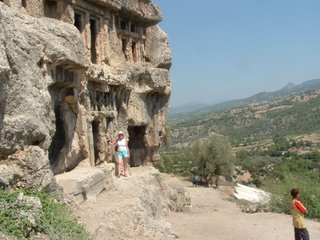
They are visible from afar and reminded us of the enormous influence that the dead must have had on the life of the living in olden days. We had lunch at the Yakapark Trout Restaurant where, while sipping one's drink at the bar, fish swim in a water canal that divides the bar in two. The sound of flowing water coming from the springs that pepper the region is everpresent and was a melodious backdrop as we sat in the open air at wooden tables sheltered by fruit trees and vines eating a freshly barbecued trout complemented by a variety of local side dishes. An idyllic situation.
A few miles away is the mountain gorge of Saklikent: after the Samaria gorge in Crete, the longest in Europe. The entrance to the gorge is along 150 metres of walkway and then one has to wade across quite rapid water that is surprisingly chilly and up to one's hips even in Summer.
It is very good fun, however, and one can then walk along the stream, climbing over some rockfalls as long as one wants. The stream is whitish/grey with the particles of limestone in suspension, and in some places, where it is reflected by rockfall, oozes out in a thickish liquid. Some people daub themselves with it and look like American Indians on the warpath and, in all probability, it may have a therapeutic effect on their skin. We never attempted it, but thoroughly enjoyed walking along the stream and feeling the mud oozing between our toes. We only did an hour's walking up the gorge owing to time constraints but, since we were both veterans of Samaria, would have really liked to have gone further. Perhaps some other day!
An entirely different experience was visiting the sunken city of Kekova. Our excursion from Ka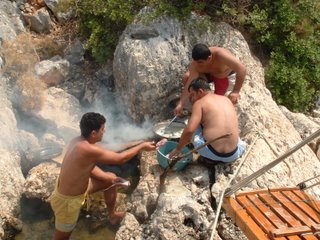 ş started wirth a bus journey to the little harbour village of Üçağiz. Here we boarded a boat which took us round various beautiful inlets and lagoons with stops for swimming in the crystal clear turquoise sea. We moored off some rocks and our crew clambered ashore and proceeded to clean and barbecue some fresh fish. Meanwhile, tables had been laid on deck and side dishes prepared while we sipped a cold beer or glass of wine available from the bar. A water melon was produced as a sweet and its remnants left on a nearby rock where an obviously expectant stag appeared from the undergrowth to enjoy its regular treat. The whole area is covered with ancient ruins some of it totally submerged as a result of earthquakes. One sees half submerged sarcophagi, house stairways hewn out of rock descending into the water, sunken shops and houses with amphora and other artefacts clearly visible a fathom or two below the surface.
ş started wirth a bus journey to the little harbour village of Üçağiz. Here we boarded a boat which took us round various beautiful inlets and lagoons with stops for swimming in the crystal clear turquoise sea. We moored off some rocks and our crew clambered ashore and proceeded to clean and barbecue some fresh fish. Meanwhile, tables had been laid on deck and side dishes prepared while we sipped a cold beer or glass of wine available from the bar. A water melon was produced as a sweet and its remnants left on a nearby rock where an obviously expectant stag appeared from the undergrowth to enjoy its regular treat. The whole area is covered with ancient ruins some of it totally submerged as a result of earthquakes. One sees half submerged sarcophagi, house stairways hewn out of rock descending into the water, sunken shops and houses with amphora and other artefacts clearly visible a fathom or two below the surface.
To get a wonderful panoramic view of the whole archipelago the boat stopped at Kale to allow us
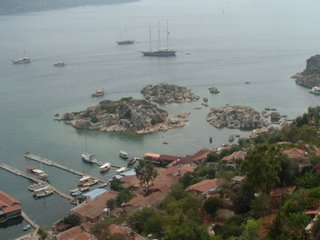
to climb to the top of a Byzantine castle. The village and small port of Kale was built on top of 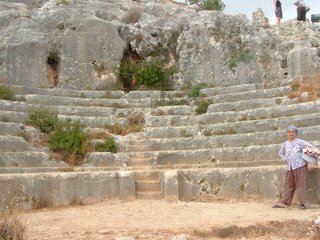 the Lycian city of Simena and the castle itself on the remains of a Roman settlement. The path up to the fort is not well defined and tourists are often met by unofficial guides having very little or no English who will not take hayir for an answer. We were picked up by a mature lady, traditionally dressed, flip-flops on her feet, holding under her arm a plastic washing up bowl containing bracelets, headscarves, etc, that she had made. She moved over the rocky slope like a goat indicating the footholds and pointing out some of the archaeological features in staccato words. Not that we needed to be told that the seven rows of semicircular seats carved into solid rock were a
the Lycian city of Simena and the castle itself on the remains of a Roman settlement. The path up to the fort is not well defined and tourists are often met by unofficial guides having very little or no English who will not take hayir for an answer. We were picked up by a mature lady, traditionally dressed, flip-flops on her feet, holding under her arm a plastic washing up bowl containing bracelets, headscarves, etc, that she had made. She moved over the rocky slope like a goat indicating the footholds and pointing out some of the archaeological features in staccato words. Not that we needed to be told that the seven rows of semicircular seats carved into solid rock were a 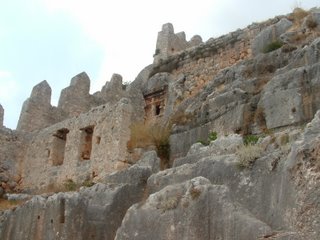 Roman theatre! We read afterwards that this was the smallest theatre, of which there are many in Lycia, and would have only held about three hundred people. But she did point out the rock tombs, fossils we might have missed and the heli-pad of wealthy Istanbul incomers. She came over as a humourous and gentle person and we warmed to her. It was interesting and perhaps indicative of her culture that she would not accept a gratuity from us but was pleased to sell a piece of her wares for lesser reward. She left us with much food for thought.
Roman theatre! We read afterwards that this was the smallest theatre, of which there are many in Lycia, and would have only held about three hundred people. But she did point out the rock tombs, fossils we might have missed and the heli-pad of wealthy Istanbul incomers. She came over as a humourous and gentle person and we warmed to her. It was interesting and perhaps indicative of her culture that she would not accept a gratuity from us but was pleased to sell a piece of her wares for lesser reward. She left us with much food for thought.
Of course, the Turks like every other people in the world are very friendly and caring and we found that they often went out of their way to talk to us and pass the time of day. Chris felt a bit faint one day having been clambering over the Roman theatre in Kaş during the hottest part of the day and had to sit down. A woman who had been sitting crocheting about fifty metres away immediately came over and, though not being able to speak any English, showed her concern and sat next to Chris until she felt Chris had recovered. Tan, one of our guides, suggested that the Turks are a very laid-back nation and we found no reason to disagree other than perhaps in the case of one carpet salesman who thought that he'd enticed us to part with £700 for, what we must admit, a rather nice carpet.
Neither Chris nor I are beach persons but we did go and visit Patara beach, a national park and a breeding ground for the endangered loggerhead turtle. The beach is an 18 kilometre-long strip of sand bordered at both ends by mountains and along its length by sand dunes and the large marshy area which was once the celebrated Lycian port of Patara. The swimming was magnificent but sitting in one of two serried ranks of sunloungers afterwards was not. Patara is an extensive archaeological site with much excavation to be done. It was supposedly the birthplace of Apollo and St Nicholas (Father Christmas) and St Paul set out for Rome by boarding a ship in its harbour. Incidentally, Chris and I had mused for quite a while over why a café/bar in Kaş was called Noel Baba! To get back to Patara, there is an inevitable Roman theatre, half covered in sand, an impressive City Gate, a silted up harbour (which was in the process of being excavated, we were told) and the ruins of streets and other buildings half hidden in sand and scrub.
Driving up from Patara into the Taurus mountains one comes to the ruins of Xanthos holding a commanding position over the valley below. It was the capital city of the Lycian Federation and has had a violent history. The Xanthosians twice demonstrated their fierce independence by committing mass suicide rather than submitting to invading armies. Xanthos' men set fire to their womwn, children, slaves and belongings before making their final doomed attack on the Persians and the same gruesome story was repeated when Brutus attacked the city in 42 BC when only a hundred or so people were saved. The following poignant verse was found on a tablet in Xanthos:
We made our houses graves
And our graves are homes to us
Our houses burned down
And our graves were looted
We climbed to the summits
We went deep into the earth
They came and got us
They burned and destroyed us
And we,
For the sake of our mothers,
Our women,
And for the sake of the dead,
And we,
In the name of our honour,
And our freedom,
We the people of this land,
Who sought mass suicide
We left a fire behind us,
Never to die out ...
On hearing the stories and reading this poem we were reminded of a memorable visit some years ago to the site of an auto-da-fé in Montsegur, France, where the Cathars had voluntarily gone to their deaths. Things don't seem to change; today people are still committing suicide for their cause.
Unsurprisingly most of the interesting findings from Xanthos are in the British Museum but there are still wonderful remains to be seen including the amazing Lycian Tower Tomb which is over 8.5 metres tall and was constructed in the 4th century BC.
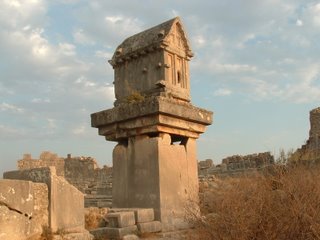
There is also, of course, the remains of another large Roman theatre! We were there at sunset and it was a magical experience to see the sun setting behind what remained of the Nereids monument and stand on rock and soil out of which appeared about fifty metres of wide marble street and realising that there was history to be discovered right there under our feet.
We spent a couple of weeks in Lesbos in 2005 and searched far and wide for old ruins and, by and large, failed miserably. Here in Turkey one can't help but trip over some ancient monument. Rock tombs and sarcophagi are everywhere; a Lycian sarcophagus is sandwiched between shops in one of the streets of Kaş and the whole town is overlooked by rock tombs.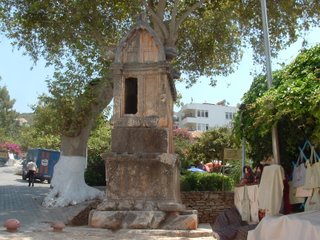
But then there is also the ruined town of Kayaköy. It was once a thriving Greek settlement called Karmylassos but the 25,000 inhabitants were repatriated to Greece in 1923 and since then has been uninhabited. It was a sobering experience standing there in the blistering 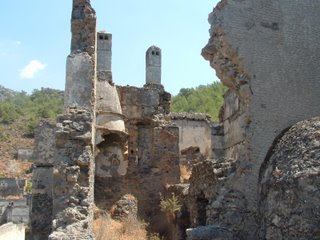
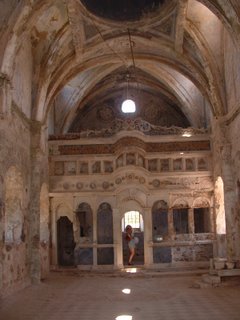 noonday sun thinking about the ruins of Xanthos that we'd stood upon the previous evening and knowing that Greeks and Turks had lived side by side in Anatolia in perfect harmony for centuries. Indeed, the Lycians had gone to help the Greeks of Troy when attacked by Sparta! What was going to happen to Kayaköy? One would hope that someday some Greeks would return and once again live in accord with their Turkish neighbours, though whether any self repecting Greek (or Turk for that matter) would want to live so close to the English outpost of Ölüdeniz is unlikely. At least Kayaköy should be preserved and looked after so that tourists like us in the distant future can remember and learn about the failings of their ancestors. An emotional relief was the adjacent Poseidon Restaurant/Café/Bar where we had the best side dishes that we'd encountered during the holiday. The wine wasn't bad either, 'home made wine' as they classified it but really meaning that it was made in Turkey.
noonday sun thinking about the ruins of Xanthos that we'd stood upon the previous evening and knowing that Greeks and Turks had lived side by side in Anatolia in perfect harmony for centuries. Indeed, the Lycians had gone to help the Greeks of Troy when attacked by Sparta! What was going to happen to Kayaköy? One would hope that someday some Greeks would return and once again live in accord with their Turkish neighbours, though whether any self repecting Greek (or Turk for that matter) would want to live so close to the English outpost of Ölüdeniz is unlikely. At least Kayaköy should be preserved and looked after so that tourists like us in the distant future can remember and learn about the failings of their ancestors. An emotional relief was the adjacent Poseidon Restaurant/Café/Bar where we had the best side dishes that we'd encountered during the holiday. The wine wasn't bad either, 'home made wine' as they classified it but really meaning that it was made in Turkey.
Our impromptu fortnight in Kaş was very enjoyable and has enhanced our perspectives on different cultures and areas of history and shown us once more that people of varying beliefs and cultures have lived together peacefully and productively and could continue to do so without the interference of politics and the people who indulge in it to gain power. We will no doubt be returning.
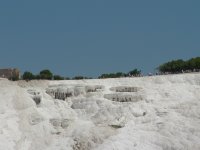
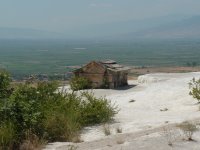
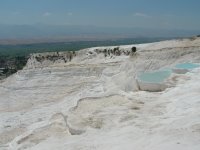
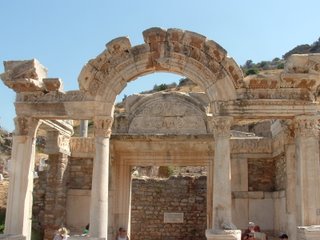
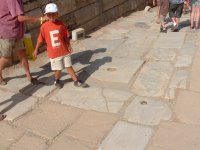
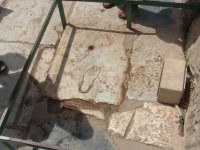
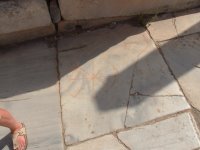
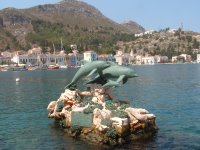
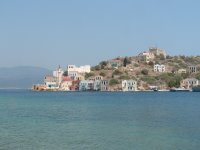
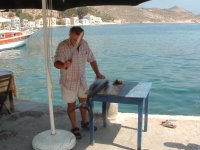
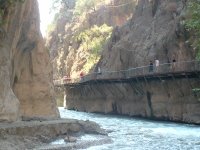
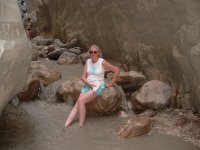
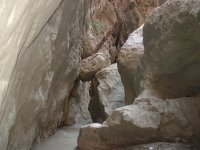
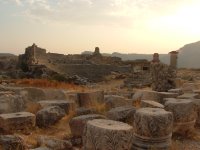
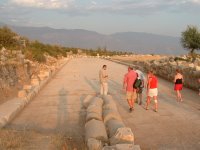
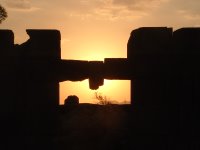

0 Comments:
Post a Comment
<< Home